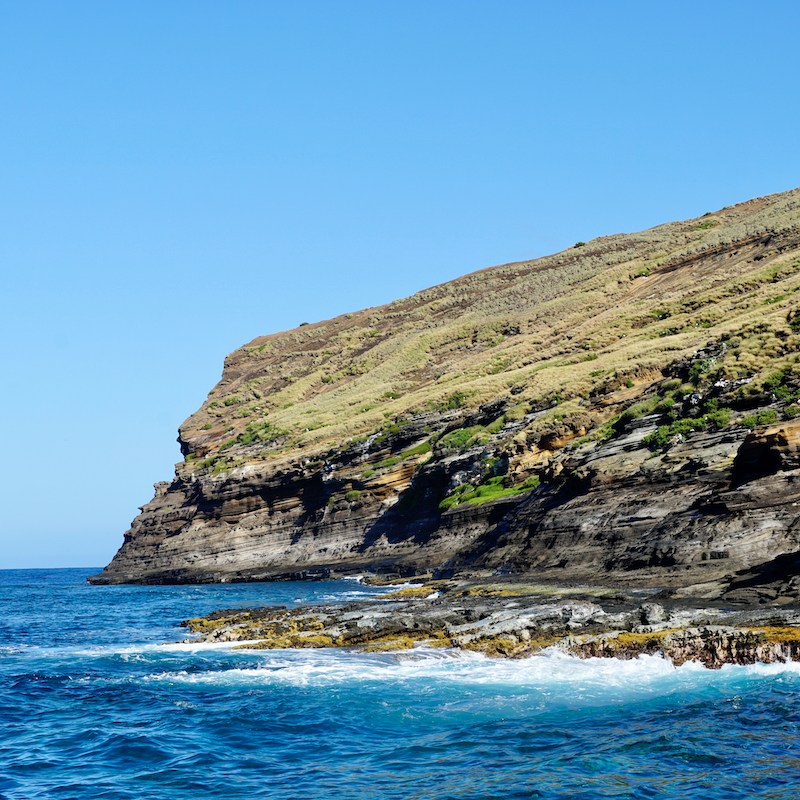
Note: The Travel Awaits team regularly updates content to provide the latest, and most accurate information to our readers. The updated content in this article may not reflect the views or opinions of the original author.
Videos by TravelAwaits
A privately owned island with an estimated 170 residents, Niihau, aka Niʻihau, is commonly referred to as Hawaii’s “Forbidden Island.” This invite-only destination tantalizes travelers from across the globe due to its extreme exclusivity.
Situated approximately 18 miles northwest of Kauai, Niihau extends 5 miles and has been privately owned for more than 150 years. While Hawaii’s Niihau Island remains closed to the public, the reasons why might come as a surprise. A hint: It’s not because you have to be rich and famous to visit the island.
Quite the contrary, Niihau’s owners are upholding a promise made to a former Hawaiian king Kamehameha to protect the island from the outside world and to maintain the island’s beloved Hawaiian heritage. If you’re curious about Hawaii’s Forbidden Island, here are 12 fascinating things to know about Niihau.

12 Fascinating Things To Know about Niihau, Forbidden Island Hawaii
1. It Was Originally Bought For $10,000 Worth Of Gold
One of the most riveting facts about the Forbidden Island has to do with the story of its purchase. History has it that in 1864, Elizabeth Sinclair originally bought the 70-square-mile island from King Kamehameha V for a mere $10,000 in gold. Though this amount of money can’t even buy a small home in today’s economy, it was quite a large sum at the time.
The king’s only request was that the Sinclair family protect the island and its residents from outside influences — a promise that still rings true today.
Today, Keith and Bruce Robinson, descendants of the Sinclairs, are the sole owners of the island and are committed to its preservation and its proud Hawaiian heritage.
In a plea to state lawmakers to help protect the island, Bruce Robinson stated that “over a hundred years ago, a king asked our family to take care of the people. We’re here today for that fulfillment of that promise.”
2. It Was Deemed The “Forbidden Island” Due To A Polio Epidemic
There are various myths and legends as to why Niihau is named the “Forbidden Island,” the most popular being that you have to be invited by the Robinsons in order to visit. Though this is presently true — minus a few exceptions you will see below — this wasn’t the case when the name was originally construed.
During a 1952 polio epidemic in the Hawaiian Islands, Niihau became known as the “Forbidden Island” since you had to have a doctor’s note to visit in order to prevent the spread of polio.
In an interview with ABC News, Bruce Robinson explained, “My uncle wanted to protect the residents here from the epidemic and it was forbidden to come out here unless you had a doctor’s certificate, and there was a 2-week quarantine. And it worked. We never got polio out here.”
These words resonate today, more than 70 years later, as another virus rampaged around the world and forced governments to close the border. However, the little-known westernmost island in the Hawaiian archipelago still retains its mystique, largely devoid of Western influences and embracing its native dialect and Hawaiian culture.
3. It Epitomizes A Nearly Forgotten Past
While some may consider it a modern-day nightmare and others view it as a peaceful utopian society, Niihau has rejected the use of today’s technologies and survives without electricity, running water, internet, shops, restaurants, paved roads, cars, or hotels.
Electricity on this famous Hawaiian island is produced by the sun or a generator, as opposed to an electric utility. There are few to no cars on the island, and most people get around by bike or on foot.
Residents on this Hawaiian island hunt and fish using age-old methods passed down from their ancestors. Unfortunately, today, the island’s natural resources are in danger. Pressures from outside sources have strained the island’s ability to uphold traditions and dying cultural practices.

4. It’s Known For Niihau Shells
Named after Kahelelani, the first chief of the island of Niihau, teeny tiny kahelelani shells are used to make Ni‘ihau shell leis and jewelry. This folk art is still practiced on the island, but you don’t have to go to Niihau to find one. They are also available on other Hawaiian islands such as Kauai, Maui, and Oahu.
5. It’s Home To The Largest Lake In Hawaii
Encompassing more than 840 acres of land, Lake Halalii is an ephemeral lake. During the rainy seasons, it becomes Hawaii’s largest lake. Since Lake Halalii’s size is dependent upon rainfall, it is sometimes referred to as a playa or intermittent lake.
Lake Halalii is situated near Halulu Lake, which, according to Niihau: The Traditions of an Hawaiian Island, is the largest natural lake in the Hawaiian Islands.
6. It May Have As Few As 70 Residents… And Its Population Is Declining
There’s a lot of debate about how many Niihauans actually live on Hawaii’s Forbidden Island, mainly due to the fact that the Robinson family isn’t required to report population numbers.
The only settlement on the island is the main village of Puʻuwai, which literally translates to “heart” in Hawaiian.
While a 2010 census estimated the island’s permanent residents to be at about 170 strong, the Niihau Cultural Heritage Foundation claims this number is closer to about 70 inhabitants.
Due to factors including limited economic opportunities, few healthcare providers, and more homesites becoming available on the nearby island of Kauai, many Niihau residents are spending more time elsewhere, eventually leaving the island behind permanently.
7. Livestock And Other Animals Roam Freely
Livestock and other animals roam freely throughout the island’s kiawe trees, a species of mesquite. Sheep, cattle, and pigs are some familiar critters that can be found throughout the island’s kiawe trees, along with more exotic animals such as herds of eland, aoudad, and oryx. According to the Niihau Cultural Heritage Foundation, these animals were brought to the island from Molokai Ranch when its wildlife park closed in 1999.
8. There Are Many Rules To Follow
Established by earlier generations and upheld by the Robinsons, there are a number of rules that permanent residents of Niihau must follow.
Residents aren’t allowed to drink alcohol or own guns, and one former resident even claimed that men are not allowed to have long hair or earrings and that the entire village must attend church on Sundays. According to the New York Times, anyone caught breaking these rules can be evicted.
9. It’s Home To The Only School In Hawaii That Relies Entirely On Solar Power
Despite the fact that Niihau doesn’t utilize many modern-day technologies, residents’ practices are quite advanced when it comes to harnessing solar power.
The island is home to Hawaii’s only school that relies entirely on solar power for electricity. In December 2007, a 10.4-kilowatt photovoltaic power system with battery storage was installed at Niihau School, making it the only school in the state — and quite possibly in the entire nation — that is run solely on solar power.
10. It’s The Only Place In Hawaii Where Native Hawaiian Is The Most-Spoken Language
The Forbidden Island is “the only place left in the world where the predominant language is Hawaiian” according to the Washington Post. When the Hawaiian monarchy was overthrown in the late 1800s, the English language began to spread, and Hawaiian was inevitably spoken less and less.
Niihau’s isolation is one reason it was able to maintain the usage of its native tongue and preserve Hawaiian culture, and the small community has even developed its own separate dialect that’s only spoken on the Island. There is a lot I didn’t know about Hawaii until I visited.

11. You Have To Be Invited To Visit The Island…
The Robinson family is so dedicated to protecting the island from the outside world and upholding the former king Kamehameha V’s wishes that you have to be invited by either a member of the Robinson family or a permanent Niihau resident in order to visit.
Though this prevents travelers from visiting Niihau Island, there are a few exceptions to the rule.
18 miles from Niihau is another beautiful island, Kauai for which you do not need an invitation. Kauai’s official nickname is “The Garden Island” due to its beautiful and lush landscapes. Kauai is also known for its many waterfalls including Waipoo Falls which tumbles 800 feet into Waimea Canyon. Two scenic waterfalls on Kauai’s east side include Opaekaa Falls and the popular Wailua Falls (shown in the opening credits of the popular TV “Fantasy Island.”)
12. …Unless You Take One Of These Tours
If you’re looking for a way around Niihau’s travel restrictions, then you’re in luck. There are now two ways that travelers can visit Hawaii’s Forbidden Island: Niihau Helicopters and Niihau Safaris.

Helicopter Tours
Niihau Helicopters offers exclusive excursions to Niihau island on executive class twin-engine helicopters. Pilots provide a historical background of the island and guests are allowed to wander its secluded beaches — sunbathing, swimming, snorkeling, looking for shells, and gazing upon beloved Hawaiian monk seals. Half-day tours cost $465 per person and group rates are available.
Hunting Safaris
The other way to visit Hawaii’s Forbidden Island is by embarking on a Niihau Safari. Niihau Safaris invites guests to a tropical and challenging safari experience, with the opportunity to hunt Polynesian boars, hybrid sheep, wild eland, aoudad, and oryx. Niihau Safaris welcomes participants of various ages and skill sets, and hunting rates are set at $3,000 per day.
FAQs
How Do Residents Live on Niihau?
People on the island generally do fishing and farming. The islanders are completely dependent on rainwater for water and use solar panels for electricity and heating. Moreover, the island has no roads, no hospitals, no police stations, or grocery stores and employment opportunities are scarce because the island is cut off from the rest of the world. Recently, the family has opened a part of the island for tourism purposes but rules still apply.
Is the Niihau & Napali Boat Tour a Good Way To See The Island?
Yes, it is certainly one of the best options to visit the “Forbidden Island”. The tour is around seven hours long and it includes snorkeling equipment, breakfast, lunch, beverages, and the opportunity to see humpback whales during the right season. The tour departs from the island of Kauai and crosses the 17-mile-wide Kaulakahi Channel to see the Lehua Crater before landing on Niihau.
Why Are Niihau Shells So Expensive?
The lei jewelry is expensive because a single lei requires hundreds of tiny shells and all the painstaking and time-consuming work that the locals put into finding the shells, sorting, and organizing them, and then stringing them delicately in intricate, decorative patterns. There are four species of Ni’ihau shells that are found only on the island of Ni’ihau. The rarity of the shells also makes Ni’ihau shell lei very expensive.
What Are the Nearest Attractions to Niihau?
Visiting Niihau island could prove difficult because of the restrictions. However, numerous more accessible locations off the coast of Kauai offer similar sightseeing opportunities. One option is a boat tour along Kauai’s iconic Na Pali Coast. Or you can pay a visit to Koke’e State Park or Waimea Canyon for multiple drive-up lookouts, vantage points, hikes, and waterfalls, or Polihale Beach for shelling, long beach walks, and spectacular sunsets.
Is It Easy To Get Invited to Hawaii’s ‘Forbidden Island’ Niihau?
No, it isn’t. In reality, there have been a few invites to outsiders but this is rare. You wouldn’t be able to just get invited on a regular basis as only family are allowed to step on Niihau. Maybe it’s for the better because such a fragile ecosystem could be upset by something you may inadvertently carry on your person. People who don’t live the life we live could easily be disrupted by disease, mites, common colds, and flu.

